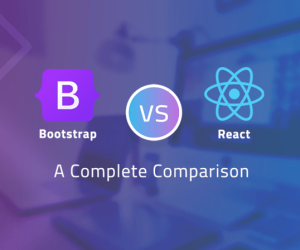 Introduction:
Introduction:
When it comes to frontend development, having the right tools can significantly impact the efficiency and quality of your work. Bootstrap and React are two popular choices that developers often consider. While both serve the purpose of enhancing frontend development, they have distinct characteristics and target different aspects of web development. In this article, we will compare Bootstrap and React, exploring their features, benefits, and use cases to help you make an informed decision for your projects.
- Bootstrap: Bootstrap is a widely used CSS framework that provides a comprehensive set of pre-built components, styles, and utilities. It simplifies frontend development by offering a responsive grid system, typography, buttons, forms, navigation, and other UI elements. Here are some key aspects of Bootstrap:
a. Ease of Use: Bootstrap’s predefined components and styles make it easy to create visually appealing and consistent interfaces. Its straightforward class-based system allows developers to quickly prototype and build responsive websites.
b. Rapid Development: By leveraging Bootstrap’s ready-to-use components, developers can speed up the development process, reducing the need for writing custom CSS and JavaScript. This results in faster project completion and efficient collaboration.
c. Responsive Design: Bootstrap’s responsive grid system and components ensure that websites automatically adapt to different screen sizes and devices. This helps deliver a consistent user experience across desktop, tablet, and mobile devices.
d. Customization: Bootstrap provides customization options, allowing developers to modify its default styles, components, and behavior to align with specific project requirements. This flexibility makes it adaptable to a wide range of design preferences.
- React: React is a JavaScript library for building user interfaces. It focuses on the creation of reusable UI components and facilitates the development of complex, interactive, and high-performance web applications. Here are some key aspects of React:
a. Component-Based Architecture: React promotes a component-based approach, where UIs are broken down into reusable components. This modular structure improves code maintainability, reusability, and scalability, making it easier to manage large-scale applications.
b. Virtual DOM: React utilizes a virtual DOM, a lightweight representation of the actual DOM. This allows for efficient rendering and updates, as React only updates the components affected by changes, rather than re-rendering the entire page.
c. State Management: React incorporates a unidirectional data flow and provides a mechanism for managing application state through its built-in state management system or third-party libraries like Redux or MobX. This simplifies the management of complex application data and ensures data consistency.
d. Ecosystem and Community: React has a large and active community, resulting in a vast ecosystem of libraries, tools, and resources. This provides developers with extensive support, third-party integrations, and a wide range of available solutions to enhance their development workflow.
- Use Cases and Considerations: a. Bootstrap: Bootstrap is well-suited for projects that prioritize rapid development, consistency, and a straightforward design approach. It is ideal for websites that require a responsive layout, consistent styling, and a wide variety of pre-built UI components. It is commonly used for marketing websites, content-based platforms, and projects with limited interactivity.
b. React: React shines in projects that demand complex and interactive user interfaces, such as single-page applications, progressive web apps, and dynamic web platforms. It excels in scenarios where real-time updates, performance optimization, and seamless component reusability are crucial. React is often preferred for building interactive dashboards, e-commerce platforms, and collaborative web applications.
Conclusion:
In the comparison between Bootstrap and React, it is essential to consider your project’s specific requirements and goals. Bootstrap excels in providing a solid foundation of pre-built components and styles for rapid development and consistent design. On the other hand, React empowers developers to build complex, interactive, and scalable web applications with its component-based architecture and efficient rendering. By understanding the strengths and use cases of both tools, you can choose the one that aligns best with your project’s needs and development priorities.
Related posts:
- Top Tech Skills For SMEs in Owerri, Imo State, Nigeria
- The Role of Data Analysis in Business Decision Making: Unlock Your Potential in Data Analysis Today!
- Cybersecurity in the Age of IoT: Protecting Connected Devices and Networks
- Cybersecurity vs Networking: Deciding Between Two Essential IT Specializations

